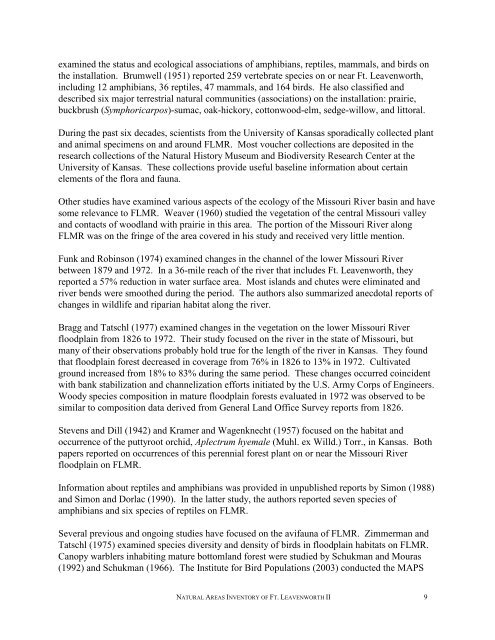A Natural Areas Inventory of the - Kansas Natural Heritage Inventory ...
A Natural Areas Inventory of the - Kansas Natural Heritage Inventory ...
A Natural Areas Inventory of the - Kansas Natural Heritage Inventory ...
You also want an ePaper? Increase the reach of your titles
YUMPU automatically turns print PDFs into web optimized ePapers that Google loves.
examined <strong>the</strong> status and ecological associations <strong>of</strong> amphibians, reptiles, mammals, and birds on<br />
<strong>the</strong> installation. Brumwell (1951) reported 259 vertebrate species on or near Ft. Leavenworth,<br />
including 12 amphibians, 36 reptiles, 47 mammals, and 164 birds. He also classified and<br />
described six major terrestrial natural communities (associations) on <strong>the</strong> installation: prairie,<br />
buckbrush (Symphoricarpos)-sumac, oak-hickory, cottonwood-elm, sedge-willow, and littoral.<br />
During <strong>the</strong> past six decades, scientists from <strong>the</strong> University <strong>of</strong> <strong>Kansas</strong> sporadically collected plant<br />
and animal specimens on and around FLMR. Most voucher collections are deposited in <strong>the</strong><br />
research collections <strong>of</strong> <strong>the</strong> <strong>Natural</strong> History Museum and Biodiversity Research Center at <strong>the</strong><br />
University <strong>of</strong> <strong>Kansas</strong>. These collections provide useful baseline information about certain<br />
elements <strong>of</strong> <strong>the</strong> flora and fauna.<br />
O<strong>the</strong>r studies have examined various aspects <strong>of</strong> <strong>the</strong> ecology <strong>of</strong> <strong>the</strong> Missouri River basin and have<br />
some relevance to FLMR. Weaver (1960) studied <strong>the</strong> vegetation <strong>of</strong> <strong>the</strong> central Missouri valley<br />
and contacts <strong>of</strong> woodland with prairie in this area. The portion <strong>of</strong> <strong>the</strong> Missouri River along<br />
FLMR was on <strong>the</strong> fringe <strong>of</strong> <strong>the</strong> area covered in his study and received very little mention.<br />
Funk and Robinson (1974) examined changes in <strong>the</strong> channel <strong>of</strong> <strong>the</strong> lower Missouri River<br />
between 1879 and 1972. In a 36-mile reach <strong>of</strong> <strong>the</strong> river that includes Ft. Leavenworth, <strong>the</strong>y<br />
reported a 57% reduction in water surface area. Most islands and chutes were eliminated and<br />
river bends were smoo<strong>the</strong>d during <strong>the</strong> period. The authors also summarized anecdotal reports <strong>of</strong><br />
changes in wildlife and riparian habitat along <strong>the</strong> river.<br />
Bragg and Tatschl (1977) examined changes in <strong>the</strong> vegetation on <strong>the</strong> lower Missouri River<br />
floodplain from 1826 to 1972. Their study focused on <strong>the</strong> river in <strong>the</strong> state <strong>of</strong> Missouri, but<br />
many <strong>of</strong> <strong>the</strong>ir observations probably hold true for <strong>the</strong> length <strong>of</strong> <strong>the</strong> river in <strong>Kansas</strong>. They found<br />
that floodplain forest decreased in coverage from 76% in 1826 to 13% in 1972. Cultivated<br />
ground increased from 18% to 83% during <strong>the</strong> same period. These changes occurred coincident<br />
with bank stabilization and channelization efforts initiated by <strong>the</strong> U.S. Army Corps <strong>of</strong> Engineers.<br />
Woody species composition in mature floodplain forests evaluated in 1972 was observed to be<br />
similar to composition data derived from General Land Office Survey reports from 1826.<br />
Stevens and Dill (1942) and Kramer and Wagenknecht (1957) focused on <strong>the</strong> habitat and<br />
occurrence <strong>of</strong> <strong>the</strong> puttyroot orchid, Aplectrum hyemale (Muhl. ex Willd.) Torr., in <strong>Kansas</strong>. Both<br />
papers reported on occurrences <strong>of</strong> this perennial forest plant on or near <strong>the</strong> Missouri River<br />
floodplain on FLMR.<br />
Information about reptiles and amphibians was provided in unpublished reports by Simon (1988)<br />
and Simon and Dorlac (1990). In <strong>the</strong> latter study, <strong>the</strong> authors reported seven species <strong>of</strong><br />
amphibians and six species <strong>of</strong> reptiles on FLMR.<br />
Several previous and ongoing studies have focused on <strong>the</strong> avifauna <strong>of</strong> FLMR. Zimmerman and<br />
Tatschl (1975) examined species diversity and density <strong>of</strong> birds in floodplain habitats on FLMR.<br />
Canopy warblers inhabiting mature bottomland forest were studied by Schukman and Mouras<br />
(1992) and Schukman (1966). The Institute for Bird Populations (2003) conducted <strong>the</strong> MAPS<br />
NATURAL AREAS INVENTORY OF FT. LEAVENWORTH II 9


